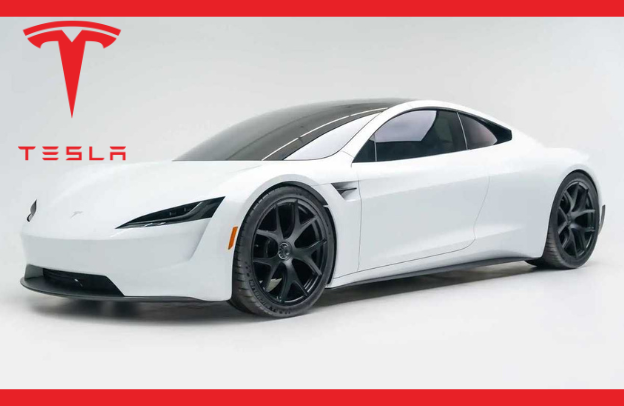The Anatomy Of Tesla’s Storytelling Strategy: The Secret Behind The Success

In the crowded U.S. automotive market, dominated by longstanding giants like Ford, Honda, and Chevrolet, the rise of Tesla Motors has been nothing short of remarkable. As a purpose-driven entrepreneur, you might wonder how Tesla, a relatively new player, managed to carve out such a distinctive position for itself in a field with so many well-established competitors.
Want to learn more about storytelling? Start by downloading the first chapter of The Storytelling Mastery.
The answer lies in its storytelling strategy—a powerful tool that you, too, can harness to elevate your business.
Tesla’s story is not just about selling electric cars; it’s about creating a compelling narrative that resonates deeply with customers and stakeholders alike. By examining how Tesla crafted and communicated its story, you can learn valuable lessons on how to stand out in any crowded market.
Learn About Innovation as a Core Message
From the outset, Tesla positioned itself not just as another car manufacturer but as a pioneer in the electric vehicle (EV) market. This wasn’t just a product positioning strategy; it was a deliberate effort to weave innovation into the very fabric of its brand narrative. To learn more about your core message, check out “Own Your Story” our signature program which offers a structured path to success in less than 90 days.
When Tesla released its flagship Model S in 2012, it wasn’t marketed simply as a car; it was heralded as a revolution in automotive technology. The Model S wasn’t just an electric vehicle; it was a powerful, sleek, and luxurious car that happened to be electric.
This subtle yet powerful messaging shift allowed Tesla to differentiate itself from other automakers who might have seen EVs as merely an eco-friendly alternative.
See also Purpose-driven Entrepreneurship: The Pathway to Sustainable Success and Personal Fulfillment
For purpose-driven entrepreneurs, the lesson here is clear: define your innovation. What is it that sets your product or service apart from others in your field? Just as Tesla did with the Model S, you need to identify that unique aspect of your offering and make it central to your story.
Remember, innovation doesn’t always have to mean inventing something entirely new. It can also mean approaching a familiar problem from a new angle or combining existing ideas in novel ways.
Tesla’s commitment to innovation went beyond the cars themselves. They also invested in creating a network of Superchargers, making long-distance travel in an electric car feasible.
This wasn’t just about providing convenience; it was about eliminating a major psychological barrier to adopting electric vehicles. Tesla’s innovation strategy consistently aimed at making its customers’ lives easier and more exciting, which in turn made the Tesla story even more compelling.
There Is Magic in Creating an Emotional Connection
One of Tesla’s greatest strengths is its ability to create an emotional connection with its customers. Owning a Tesla isn’t just about driving a car; it’s about being part of a movement towards a more sustainable future. To better connect with your audience, see “Own Your Story” our program which offers a structured path to success in less than 90 days.
This is a powerful narrative that resonates with environmentally conscious consumers who are looking for more than just a product—they want to support a cause.
See also The Art of Connection: Building Loyalty Through Authentic Brand Stories
Consider how Tesla has built this emotional connection. The company’s marketing often features sleek images of its cars against stunning natural backdrops, reinforcing the idea that driving a Tesla is both a luxurious and an environmentally friendly choice. Furthermore, Tesla’s commitment to sustainability goes beyond its cars.
They have invested in solar energy products and battery storage solutions, underscoring their mission to accelerate the world’s transition to sustainable energy.
As an entrepreneur, think about how you can create a similar emotional bond with your customers.
- What deeper values does your brand represent?
- How can you communicate these values in a way that resonates with your audience?
People are more likely to support businesses that reflect their own values, so make sure your story aligns with the values of your target market.
The Role of a Charismatic Leader
Another key element of Tesla’s storytelling strategy is its charismatic leader, Elon Musk. Musk is more than just the CEO; he is the face of the brand and often embodies the qualities that Tesla wants to convey—innovation, ambition, and a relentless drive to push the boundaries of what’s possible.
See also 6 success habits of Elon Musk you can apply today in your business
This personal connection between Musk and Tesla’s brand narrative is no accident; it’s a carefully crafted element of the company’s storytelling strategy.
Musk’s ability to capture the public’s imagination is a significant asset for Tesla. His bold vision and willingness to take risks make him a compelling figure, and his personal brand is closely tied to Tesla’s.
For example, when Musk tweets about new Tesla developments or shares his thoughts on the future of technology, it garners widespread media attention, amplifying Tesla’s story far beyond traditional marketing channels.
However, it’s not just about having a charismatic leader; it’s about how that leader communicates the company’s vision and values. Musk often speaks about Tesla’s mission to transition the world to sustainable energy, framing the company’s work as part of a broader effort to combat climate change and promote a sustainable future.
Do you want to own your story and leverage it in your business? Take this quick self-assessment survey to find out.
This narrative not only appeals to environmentally conscious consumers but also to investors and stakeholders who see Tesla as more than just a car company.
For you, the takeaway is that having a strong, relatable leader who can communicate your company’s vision, and values can be a powerful storytelling tool.
Even if you’re not the face of your company, having someone who can speak passionately and authentically about what your business stands for can help create a stronger emotional connection with your audience.
You might also like to see our previous article – Has Tesla Hit a Roadblock? Exploring the Electric Car Giant’s Challenges
Lessons for Purpose-Driven Entrepreneurs
Now that you understand some of the key elements of Tesla’s storytelling strategy, let’s explore how you can apply these lessons to your own business.
Define and Own Your Narrative:
The first step in effective storytelling is defining your narrative. What is the unique story that only you can tell? Tesla’s narrative is about innovation and sustainability, but your story might be about craftsmanship, community, or empowerment.
Whatever it is, make sure it’s clear, compelling, and authentic. Your narrative should be woven into every aspect of your business, from your marketing materials to the way you interact with customers.
Leverage Leadership for Storytelling:
Whether it’s you or another figure in your company, having a strong leader who can embody and communicate your company’s mission is crucial. This doesn’t mean you have to be a larger-than-life figure like Elon Musk, but you do need to be passionate and authentic.
Share your journey, your challenges, and your vision for the future. People are drawn to stories of struggle and perseverance, so don’t be afraid to be vulnerable and share your story.
Innovate and Disrupt:
Tesla’s story is compelling because it’s about innovation and disruption. The company didn’t just create a better electric car; it redefined what an electric car could be. As an entrepreneur, think about how you can disrupt your industry. What conventions can you challenge?
What new ideas can you bring to the table? Innovation doesn’t always mean creating something entirely new; it can also mean finding a better way to do something or challenging the status quo.
See also Cultivating Resilience: Innovations in Disaster-Proofing Crops
Create an Emotional Connection:
Tesla’s story resonates because it taps into people’s emotions and values. To create a similar connection with your customers, think about what values your brand represents and how you can communicate them in a way that resonates with your audience.
Are you passionate about sustainability, quality, or community? Make sure these values are reflected in every aspect of your business, from your marketing materials to the way you interact with customers.
Be Transparent and Bold:
One of Tesla’s trademarks is its transparency and bold vision. The company is open about its challenges and ambitious in its goals, which helps build trust and excitement among consumers.
As an entrepreneur, don’t be afraid to share your vision and be transparent about your journey. People are more likely to support businesses that are honest and authentic, so be open about your challenges and your vision for the future.
Standing Out in a Competitive Market: Marketing Strategies Inspired by Tesla
In addition to its storytelling strategy, Tesla’s approach to marketing offers several valuable lessons for entrepreneurs. Unlike many companies that rely on traditional advertising, Tesla’s marketing strategy is heavily product-centric.
The company focuses on creating exceptional products and then relies on word-of-mouth and organic growth to drive sales. This approach not only saves on advertising costs but also helps build a loyal customer base.
For example, when the Model S was first released, it quickly became known as a game-changer in the automotive industry. This wasn’t just because of its innovative features, but also because of the way Tesla marketed it.
The company focused on showcasing the car’s performance and design, letting the product speak for itself. This approach created a sense of excitement and exclusivity around the brand, which helped drive demand.
See also Beyond Profit: How Entrepreneurs Can Create Meaningful Change
As an entrepreneur, think about how you can adopt a similar product-centric approach to your marketing. Focus on creating exceptional products or services and let your customers be your best marketers.
Encourage word-of-mouth referrals and create opportunities for your customers to share their experiences with others. This can help build a loyal customer base and create a sense of community around your brand. This has been found to be very powerful across industries.
Tesla also excels at creating a community around its brand. The company’s customers are often passionate brand ambassadors who are eager to share their experiences and advocate for the brand.
This sense of community is fostered through events like Tesla’s annual shareholder meetings, where customers and fans can engage with the company and learn more about its vision for the future.
See also Address to the Community of Orlando, Florida, After Meeting Privately with Families of the Victims
To create a similar community around your brand, think about how you can engage with your customers and make them feel like part of your story. This could be through events, social media, or other forms of direct engagement.
The goal is to create a sense of belonging and loyalty among your customers, so they feel invested in your brand and are more likely to advocate for it.
Challenges and Considerations: The Flip Side of a Strong Narrative
While Tesla’s storytelling strategy has been a significant factor in its success, it’s important to note that there are also challenges associated with building a strong narrative. One of the main risks is over-reliance on a single narrative or leader.
In Tesla’s case, the company’s story is closely tied to Elon Musk, which can be both a strength and a weakness. While Musk’s vision and charisma have helped drive Tesla’s growth, the company also faces risks if Musk’s reputation is damaged or if he steps down from his role.
As an entrepreneur, it’s important to think about how you can build a strong narrative that isn’t overly reliant on a single individual. While having a charismatic leader can be a powerful storytelling tool, it’s also important to build a strong brand identity that can stand on its own.
This means investing in your company’s culture, values, and customer relationships so that your brand can thrive even if there are leadership changes.
Another challenge is managing expectations. Tesla’s bold promises and ambitious goals have sometimes led to scrutiny and skepticism from both the media and consumers. While it’s important to be ambitious and set big goals, it’s also important to be realistic and manage expectations.
See also Overcoming Hurdles: Real Stories from Successful Purpose-Driven Entrepreneurs
Over-promising and under-delivering can damage your brand’s reputation, so it’s important to strike a balance between ambition and realism.
To manage expectations, be transparent about your challenges and setbacks, and communicate your goals and timelines clearly. This can help build trust with your customers and stakeholders and ensure that they have a realistic understanding of what to expect from your business.
Conclusion: The Enduring Power of a Well-Told Story
Tesla’s rise in the automotive industry is a testament to the power of effective storytelling. By defining a clear narrative, leveraging strong leadership, and creating an emotional connection with its customers, Tesla has managed to stand out in a crowded market and build a loyal customer base.
As a purpose-driven entrepreneur, you can learn valuable lessons from Tesla’s storytelling strategy and apply them to your own business to stand out and connect with your audience.
You might also like to see Outshining Rivals: How Storytelling Makes Your Competition Irrelevant
Remember, a compelling story is more than just a marketing tool—it’s a way to connect with your customers on a deeper level, communicate your values, and build a lasting brand.
So, take the time to define your narrative, invest in your leadership, and create a strong emotional connection with your audience. By doing so, you can build a brand that not only stands out in a crowded market but also inspires and engages your customers for years to come.
Want to learn more about storytelling? Start by downloading the first chapter of The Storytelling Mastery.






